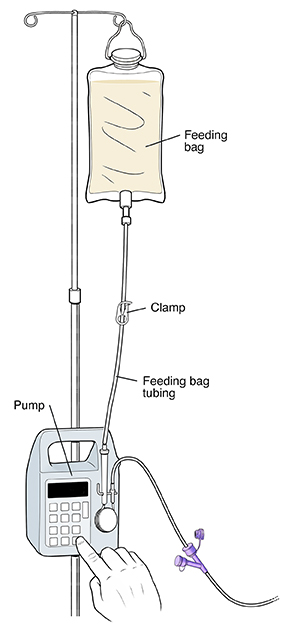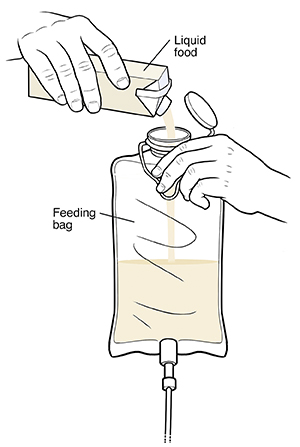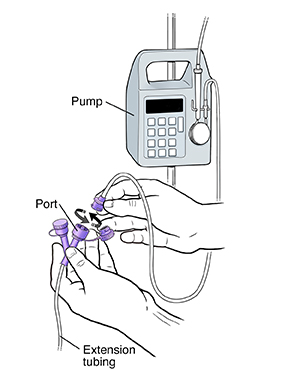Your Child's Gastrostomy or Gastro-jejunum Tube: Pump Feeding
Your child is going home with either a gastrostomy tube (G-tube) or gastro-jejunum tube (G-J tube) in place. A G-tube is placed through the belly (abdominal) wall into the stomach. This tube sends liquid food directly into the stomach. A G-J tube is placed through the belly (abdominal) wall into the stomach. It leads into part of the small intestine called the jejunum. The tube sends liquid food directly into the jejunum.
You’ll need to feed your child through their tube. You were shown how to do this before your child was discharged from the hospital. This sheet will help you remember those steps at home. If you need more help, talk with the hospital staff. Ask them how to arrange a home health nurse to help you.
Keep in mind that there are many types of G and G-J tubes, syringes, and feeding pumps. Your child’s tube and supplies may look or work differently from what are described and shown here. One type of tube has a connection that lets you plug or push the syringe into the G or G-J tube port. Another type has a twist-on safety connector. The twist-on safety connector means you must use a certain type of syringe that screws onto your child's G or G-J tube port. Follow the instructions from your child’s healthcare provider or home health nurse.
Take care to keep the tube from becoming a strangulation risk to your child. Follow your healthcare team's advice on how to secure the tube safely.
Contact information to keep handy
Ask hospital staff for phone numbers to call if you need help. Also, make sure you have the phone number for your child’s medical supply company. You’ll need to order more supplies for your child in the future. Write down all of the phone numbers below:
Healthcare provider: ____________________________________
Home health nurse: _____________________________________
Medical supply company: __________________________________
Types of feeding
There are two types of feeding with G and G-J tubes. Your child may be have one or both types of feeding. They are:
-
Continuous feeding. Liquid food is dripped slowly through the tube for part or all of a day. Continuous feeding can be done into either the stomach or the jejunum. This type of feeding is only done using a pump. The amount of food to be given and the time frame are often set on the pump for you. Don't change pump settings unless you’re told to do so.
-
Bolus feeding. This is a meal-sized amount of liquid food. It's given through the tube a few times a day. Bolus feeding is done using a syringe or a pump to get food into the stomach. Your child’s provider or home health nurse will tell you how much liquid food to use for each feeding. You’ll also be told how often to feed your child.
For bolus feeding, fill in the numbers below:
Feed your child on this schedule: ____________________________________________
Give this much at each feeding: ______________________________________________
Feeding your child

The supplies you’ll need are:


Follow these steps if the tubing has clamps:
-
Wash your hands with soap and water.
-
Make sure the pump is in the Stop/Off mode.
-
Check the label and expiration date of the liquid food. Don’t use any can or bag of food if the expiration date has passed. Instead, get a new can or bag of food.
-
Make sure that the clamp on the feeding bag tubing is closed.
-
Pour a little more than the prescribed amount of liquid food into the feeding bag.
-
Hang the feeding bag on the pole above the pump. Make sure the feeding bag tubing hangs straight.
-
Open the feeding bag clamp slowly. Let a small amount of food run through the end of the feeding bag tubing. This clears air out of the feeding bag tubing. It also helps keep your child from having gas later.
-
Close the clamp on the feeding bag tubing.
-
Load the feeding bag tubing into the pump.
-
Open the feeding port cap of the G or G-J tube.
-
Connect the extension tubing to the feeding port of the G or G-J tube.
-
Make sure the clamp on the extension tubing is closed.
-
Connect the feeding bag tubing to the other end of the extension tubing.
-
Open the clamps on both the feeding bag tubing and extension tubing.
-
Check that the settings on the pump are correct.
-
Turn the pump to Start/On mode.
-
After the feeding is done:
-
Disconnect the feeding bag tubing from the extension tubing.
-
Flush the extension tubing with water as you were shown in the hospital.
-
Disconnect the syringe from the extension tubing.
-
Disconnect the extension tubing from the G or G-J tube.
-
Close the feeding port cap of the G or G-J tube.
-
Never place medicine down the feeding tube if you weren't told to do so. This can cause the tube to clog and not work.
Follow these steps if the tubing doesn't have clamps:
-
Wash your hands with soap and water.
-
Open the feeding port and flush with the amount of water recommended by your child's provider.
-
Hang the feeding bag on the pole above the pump. Make sure the feeding bag tubing hangs straight.
-
Follow the pump manufacturer's instructions for loading the feeding bag tubing into the pump and close the pump door.
-
Check the label and expiration date of the liquid food. Don’t use any can or bag of food if the expiration date has passed. Instead, get a new can or bag of food.
-
Pour a little more than the prescribed amount of liquid food into the feeding bag.
-
Squeeze the air out of the bag and close it.
-
Prime the tubing to release any air. This will prevent the air from going into your child’s body and causing discomfort. Follow the pump manufacturer's instructions on how to prime the tubing using the automatic prime feature or follow your healthcare team's specific instructions on how to prime the tube.
-
Open the feeding port cap of the G or G-J tube.
-
Connect the extension tubing to the feeding port of the G or G-J tube.
-
Set the pump to desired settings and start the feeding.
After the feeding is done:
-
Disconnect the tubing from your child's feeding tube.
-
Flush the extension tubing with water as you were shown in the hospital.
-
Disconnect the extension tubing from the G or G-J tube.
-
Close the feeding port cap of the G or G-J tube.
-
Never place medicine down the feeding tube if you weren't told to do so. This can cause the tube to clog and not work.
Additional instructions:
_______________________________________________________________________
_______________________________________________________________________
_______________________________________________________________________
When to call the healthcare provider
Call the healthcare provider right away if any of the following takes place:
-
You see blood around the tube, in your child’s stool, or in the contents of the stomach. Depending on the amount, you may be directed to call 911.
-
The tube feels loose or comes out.
-
The opening where the tube enters the skin gets larger.
-
Red, rough tissue forms around the tube site.
-
The tube gets clogged or blocked and you can’t clear it.
-
The skin around the tube site has redness, swelling, leaking fluid, or sores.
-
Your child coughs, chokes, or vomits while feeding.
-
Your child’s belly looks bloated or feels hard when gently pressed.
-
Your child has diarrhea or constipation.
-
Your child has a fever 100.4°F (40°C) or higher in a child of any age or as directed by the provider.
Call 911
Call 911 if: